A Comparison of Empirical Procedures for Fatigue Damage Prediction in Instrumented Risers Undergoing Vortex-Induced Vibration
Abstract
:1. Introduction
2. Model Riser and Data Sets
3. Empirical Fatigue Damage Estimation
3.1. Weighted Waveform Analysis
3.2. Modified Weighted Waveform Analysis
3.3. Proper Orthogonal Decomposition
3.4. Modal Phase Reconstruction
3.5. Hybrid Method: MPR + Modified WWA
4. Fatigue Damage Estimation Based on a Large Number of Sensors
- (i)
- With the WWA method, a large number of modes can be interpreted from a suite of measurements. The modified WWA method can better account for the effects of traveling waves and localized curvature changes but fewer modes can be interpreted or used in reconstruction of strains at any target location. As a consequence, in this study where a large number of sensors (twenty-three) are available, fatigue damage rates estimated over the entire riser length by the WWA and the modified WWA methods are generally of comparable accuracy (see Figure 8a,b).
- (ii)
- Fatigue damage rates estimated by the POD and MPR methods are quite similar since both methods are affected by the quality of the unavoidable interpolation—it may be noted that the presence of sensors close to a target location leads to good estimation of the fatigue damage there; however, when nearby sensors are not present, as is the case for sensor no. 9 indicated by the red ellipses in Figure 8c,d, fatigue damage estimates are less accurate.
- (iii)
- The fatigue damage rates for the two uniform current data sets estimated either by the POD or the MPR method are less accurate than those estimated by the WWA or the modified WWA method; one likely reason for this is due to the strong non-stationary response characteristics indicated particularly in the two uniform current data sets (see Shi et al. [35]) that more directly affect the accuracy of the POD and the MPR methods. With the WWA and the modified WWA methods, the modal weights are solved for at each time instant (see Equation (7)); the POD and the MPR methods, on the other hand, assume that the riser response is described by a stationary process and decomposition of the measured response is based on the entire record (see Equations (11) and (16)). To reduce the influence of the non-stationary characteristics of the measured response on fatigue damage estimation, one possible approach is to divide the recorded response time series into shorter segments and then to employ the POD or MPR methods on those shorter segments.
- (iv)
- Generally, when a large number of sensors is available, as is the case with the NDP model riser, all five of the empirical methods estimate fatigue damage rates over the entire riser length quite well; the variability factors are typically in the range from 0.3 to 3.0, with lowest and highest estimations of 0.16 and 14.54, respectively. Among the five methods, the hybrid method (Figure 8e) which combines the MPR and the modified WWA procedures, is the most accurate for fatigue damage estimation.
5. Fatigue Damage Estimation Based on a Small Number of Sensors
6. Sensor Location and Spatial Aliasing
7. Discussion
- (i)
- With careful selection of the riser modes for inclusion, the WWA method has the ability to preserve higher harmonics in the reconstructed riser response since the selected modes in the method are non-sequential. Because the modal weights are solved for at each time instant, non-stationary characteristics, if present, have a limited influence on response reconstruction with this method. The WWA method works particularly well if only a small number of sensors is available and it relies on assumed mode shapes that are based on knowledge of the physical properties of the riser. Computation with the WWA method is fast.
- (ii)
- The modified WWA method can account for the influence of higher harmonics as long as a large number of sensors is available. This method is more versatile than the WWA method in accounting for the effect of traveling waves. Like the WWA method, it also accounts for non-stationary characteristics, but it is not well-suited for cases where only a small number of sensors is available since a greater number of modal weights need to be estimated than with WWA. The modified WWA method relies on assumed mode shapes and computation is fast.
- (iii)
- The POD method preserves frequency components and higher harmonics in the reconstructed riser response by empirical decomposition of the spatio-temporal data. This is evident from the power spectra as well as curvature plots that reveal high-frequency energy and large curvatures (or small wavelengths). POD only relies entirely on the data collected; the method identifies empirical mode shapes directly from the data, without the need for knowledge of the physical properties of the riser. The POD scheme is the fastest among the five methods; however, POD does not account for non-stationary response characteristics. The method is not well-suited when only a small number of sensors is available because of inaccuracies in the reconstructed response that arise due to the need for spatial interpolation or extrapolation from discrete empirical modes to any target location.
- (iv)
- As is the case for the POD method, the MPR method accounts for higher harmonics in the response and only relies on data, not on physical properties of the riser to estimate complex riser modes. MPR, however, is not well-suited to situations where the riser response exhibits strong non-stationary characteristics or when only a small number of sensors is available. Computation with the MPR method is slow. Importantly, MPR explicitly accounts for traveling waves in decomposing the measured response.
- (v)
- The hybrid method (which combines the MPR and modified WWA methods) has the ability to account for higher harmonics and the effect of traveling waves; it also works quite well even if only a small number of sensors is available. The hybrid method does not explicitly take into consideration non-stationary characteristics, but reconstruction even with fairly strong non-stationary response is superior to that resulting from use of the POD and MPR methods. The hybrid method needs to assume modes in the second step of the modal weight estimation for the complex MPR modes. Although the hybrid method is the slowest due to the greater computational effort relative to the other methods, it is the most accurate both for a large as well as a small number of input sensors.
8. Conclusions
- (i)
- For the case where traveling waves are not dominant in the riser’s response, the WWA method is preferred over the modified WWA method for response reconstruction over the entire riser span. For the case where strong traveling waves exist and when a sufficient number of sensors is available, the modified WWA procedure may be a better choice than the WWA procedure.
- (ii)
- If very limited or no physical information about the riser is available, the POD or MPR methods may be employed to estimate the response over the region where sensors are closely spaced, no matter whether traveling waves are indicated or not.
- (iii)
- The hybrid method appears to be the most accurate among the five methods tested, no matter how dominant the influence of traveling waves is and no matter how many sensors are available.
Author Contributions
Funding
Acknowledgments
Conflicts of Interest
Abbreviations
| VIV | vortex-induced vibration |
| WWA | weighted waveform analysis |
| POD | proper orthogonal decomposition |
| MPR | modal phase reconstruction |
| CFD | computational fluid dynamics |
| RANS | Reynolds-averaged Navier-Stokes |
| NDP | Norwegian deepwater programme |
| CSP | concentrated solar power |
| CF | cross-flow |
| IL | inline |
| RMS | root-mean-square |
| PSD | power spectral density |
| DMD | dynamic mode decomposition |
References
- Tognarelli, M.A.; Taggart, S.; Campbell, M. Actural VIV Fatigue Response of Full Scale Drilling Risers: With and without Suppression Devices. In Proceedings of the 27th International Conference on Offshore Mechanics and Arctic Engineering, Estoril, Portugal, 15–20 June 2008; p. 57046. [Google Scholar]
- Vandiver, J.K.; Swithenbank, S.B.; Jaiswal, V.; Jhingran, V. Fatigue Damage from High Mode Number Vortex-Induced Vibration. In Proceedings of the 25th International Conference on Offshore Mechanics and Arctic Engineering, Hamburg, Germany, 4–9 June 2006; p. 9240. [Google Scholar]
- Jhingran, V.; Vandiver, J.K. Incorporating the Higher Harmonics in VIV Fatigue Predictions. In Proceedings of the 26th International Conference on Offshore Mechanics and Arctic Engineering, San Diego, CA, USA, 10–15 June 2007; p. 29352. [Google Scholar]
- Modarres-Sadeghi, Y.; Mukundan, H.; Dahl, J.M.; Hover, F.S.; Triantafyllou, M.S. The Effect of Higher Harmonic Forces on Fatigue Life of Marine Risers. J. Sound Vib. 2010, 329, 43–55. [Google Scholar] [CrossRef]
- Constantinides, Y.; Oakley, O.H.; Holmes, S. CFD high L/D riser modeling study. In Proceedings of the 26th International Conference on Offshore Mechanics and Arctic Engineering, San Diego, CA, USA, 10–15 June 2007. [Google Scholar]
- Huang, K.; Chen, H.C.; Chen, C.R. Riser VIV induced fatigue assessment by a CFD approach. In Proceedings of the 18th International Offshore and Polar Engineering Conference, Vancouver, BC, Canada, 6–11 July 2008. [Google Scholar]
- Huang, K.; Chen, H.C.; Chen, C.R. Vertical riser VIV simulation in uniform current. J. Offshore Mech. Arct. Eng. 2010, 132, 1–10. [Google Scholar] [CrossRef]
- Wu, G.; Ma, W.; Kramer, M.; Kim, J.W.; Jang, H.; O’Sullivan, J. Vortex Induced Motions of a Column Stabilized Floater Part II: CFD Benchmark and Prediction. In Proceedings of the International DOT Conference, Aberdeen, UK, 8–12 July 2014. [Google Scholar]
- Iaccarino, G.; Mishra, A.A.; Ghili, S. Eigenspace perturbations for uncertainty estimation of single-point turbulence closures. Phys. Rev. Fluids 2017, 2, 024605. [Google Scholar] [CrossRef]
- Pan, Z.Y.; Cui, W.C.; Miao, Q.M. Numerical simulation of vortex-induced vibration of a circular cylinder at low mass-damping using RANS code. J. Fluids Struct. 2007, 23, 23–37. [Google Scholar] [CrossRef]
- Shi, C.; Manuel, L.; Tognarelli, M.A. Alternative Empirical Procedures for Fatigue Damage Rate Prediction of Instrumented Risers undergoing Vortex-Induced Vibration. In Proceedings of the 29th International Conference on Offshore Mechanics and Arctic Engineering, Shanghai, China, 6–11 June 2010. Paper no. 20992. [Google Scholar]
- Cachafeiro, H.; de Arevalo, L.F.; Vinuesa, R.; Goikoetxea, J.; Barriga, J. Impact of Solar Selective Coating Ageing on Energy Cost. Energy Procedia 2015, 69, 299–309. [Google Scholar] [CrossRef]
- Trim, A.D.; Braaten, H.; Lie, H.; Tognarelli, M.A. Experimental Investigation of Vortex-induced Vibration of Long Marine Risers. J. Fluids Struct. 2005, 21, 335–361. [Google Scholar] [CrossRef]
- Braaten, H.; Lie, H. NDP Riser High Mode VIV Tests; Main Rerport No. 512394.00.01; Norwegian Marine Technology Research Institute: Trondheim, Norway, 2004. [Google Scholar]
- Vinuesa, R.; Schlatter, P.; Nagib, H.M. Role of data uncertainties in identifying the logarithmic region of turbulent boundary layers. Exp. Fluids 2014, 55, 1751. [Google Scholar] [CrossRef]
- Vinuesa, R.; Nagib, H.M. Enhancing the accuracy of measurement techniques in high Reynolds number turbulent boundary layers for more representative comparison to their canonical representations. Eur. J. Mech. B Fluids 2016, 55, 300–312. [Google Scholar] [CrossRef]
- Vortex Induced Vibration Data Repository; Center for Ocean Engineering, MIT: Cambridge, MA, USA, 2007; Available online: http://web.mit.edu/towtank/www/vivdr/datasets.html (accessed on 10 October 2018).
- Baarholm, G.S.; Larsen, C.M.; Lie, H. On Fatigue Damage Accumulation from In-line and Cross-flow Vortex-induced Vibrations on Risers. J. Fluids Struct. 2006, 22, 109–127. [Google Scholar] [CrossRef]
- Miner, M.A. Cumulative Damage in Fatigue. Trans. ASME J. Appl. Mech. 1945, 12, 159–164. [Google Scholar]
- Matsuishi, M.; Endo, T. Fatigue of Metals Subjected to Varying Stress; Japan Society of Mechanical Engineers: Jukvoka, Japan, 1968. [Google Scholar]
- Downing, S.D.; Socie, D.F. Simple Rainflow Counting Algorithms. Int. J. Fatigue 1982, 4, 31–40. [Google Scholar] [CrossRef]
- Bai, Y.; Bhattacharyya, R.; McCormick, M.E. Pipelines and Risers; Elsevier Science Ltd.: New York, NY, USA, 2001. [Google Scholar]
- Lie, H.; Kaasen, K.E. Modal Analysis of Measurements from A Large-scale VIV Model Test of A Riser in Linearly Sheared Flow. J. Fluids Struct. 2006, 22, 557–575. [Google Scholar] [CrossRef]
- Shi, C. Fatigue Damage Prediction in Deepwater Marine Risers due to Vortex-Induced Vibration; The University of Texas at Austin: Austin, TX, USA, 2011. [Google Scholar]
- Shi, C.; Park, J.; Manuel, L.; Tognarelli, M.A. A Data-Driven Mode Identification Algorithm for Riser Fatigue Damage Assessment. J. Offshore Mech. Arct. Eng. Trans. ASME 2014, 136, 031702. [Google Scholar] [CrossRef]
- Mukundan, H.; Modarres-Sadeghi, Y.; Dahl, J.M.; Hover, F.S.; Triantafyllou, M.S. Monitoring VIV fatigue damage on marine risers. J. Fluids Struct. 2009, 25, 617–628. [Google Scholar] [CrossRef] [Green Version]
- Mukundan, H. Vortex-Induced Vibration of Marine Risers: Motion and Force Reconstruction from Field and Experimental Data; Massachusetts Institute of Technology: Cambridge, MA, USA, 2008. [Google Scholar]
- Kleiven, G. Identifying VIV Vibration Modes by Use of the Empirical Orthogonal Functions Technique. In Proceedings of the 21st International Conference on Offshore Mechanics and Arctic Engineering, Oslo, Norway, 23–28 June 2002; p. 28425. [Google Scholar]
- Srivilairit, T.; Manuel, L. Vortex-induced Vibration and Coincident Current Velocity Profiles for a Deepwater Drilling Riser. In Proceedings of the 26th International Conference on Offshore Mechanics and Arctic Engineering, San Diego, CA, USA, 10–15 June 2007; p. 29596. [Google Scholar]
- Stoer, J.; Bulirsch, R. Introduction to Numerical Analysis, 3rd ed.; Springer: New York, NY, USA, 2002. [Google Scholar]
- Press, W.H.; Teukolsky, S.A.; Vetterling, W.T.; Flannery, B.P. Numerical Recipes in C: The Art of Scientific Computing, 2nd ed.; Cambridge University Press: Cambridge, UK, 1992. [Google Scholar]
- Giacaglia, G.E.O. Trigonometric Interpolation. Celestial Mech. Dyn. Astron. 1969, 1, 360–367. [Google Scholar] [CrossRef]
- Schmid, P. Dynamic Mode Decomposition of Numerical and Experimental Data. J. Fluid Mech. 2010, 656, 5–28. [Google Scholar] [CrossRef]
- Lucor, D.; Mukundan, H.; Triantafyllou, M.S. Riser Modal Identification in CFD and Full-scale Experiments. J. Fluids Struct. 2006, 22, 905–917. [Google Scholar] [CrossRef]
- Shi, C.; Manuel, L.; Tognarelli, M.A.; Botros, T. On the vortex-induced vibration response of a model riser and location of sensors for fatigue damage prediciton. J. Offshore Mech. Arct. Eng. Trans. ASME 2012, 134, 031802. [Google Scholar] [CrossRef]
- Shi, C.; Manuel, L.; Tognarelli, M.A. Empirical Procedures for Long-Term Prediction of Fatigue Damage for an Instrumented Marine Riser. J. Offshore Mech. Arct. Eng. Trans. ASME 2014, 136, 031402. [Google Scholar] [CrossRef]
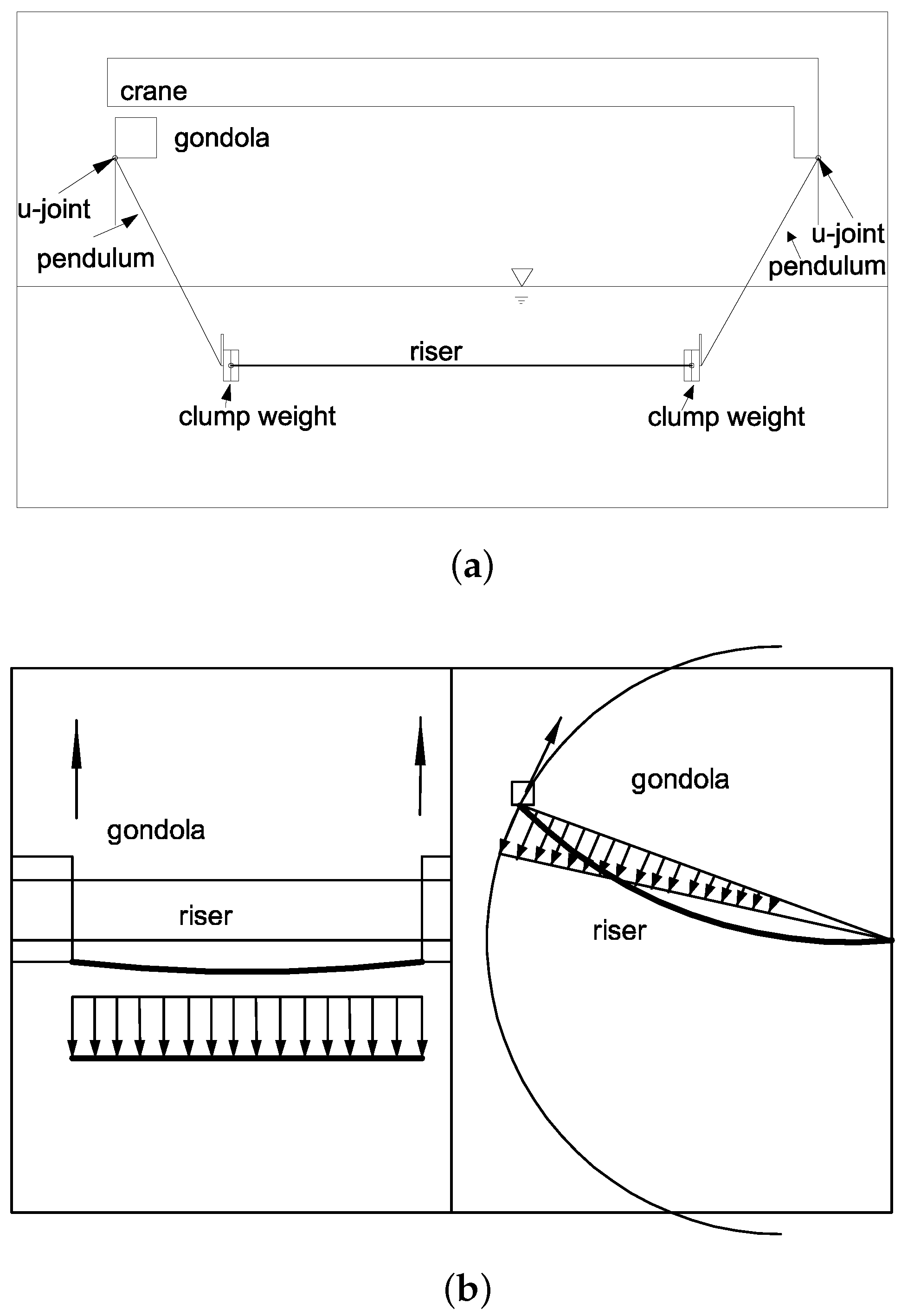
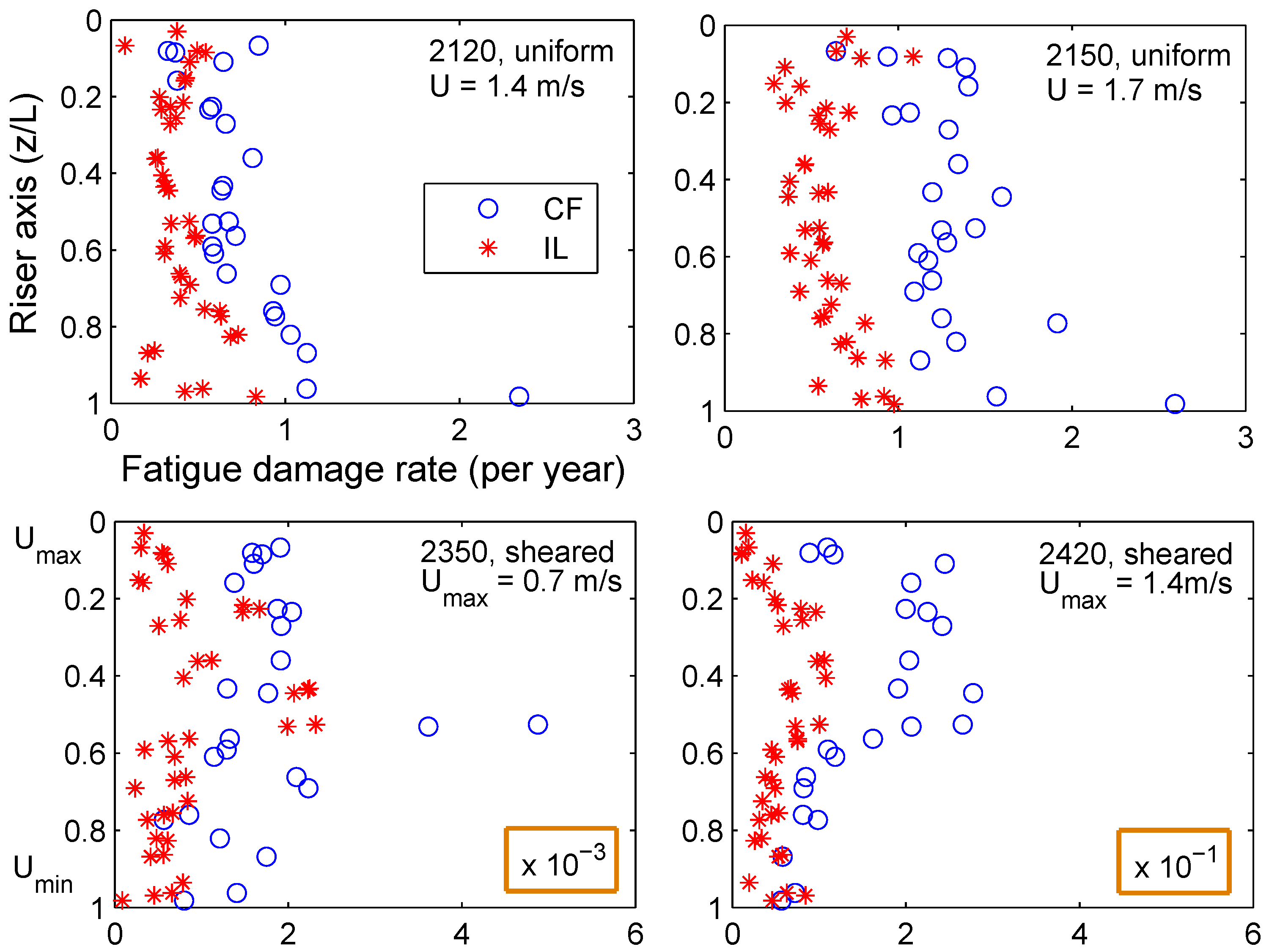
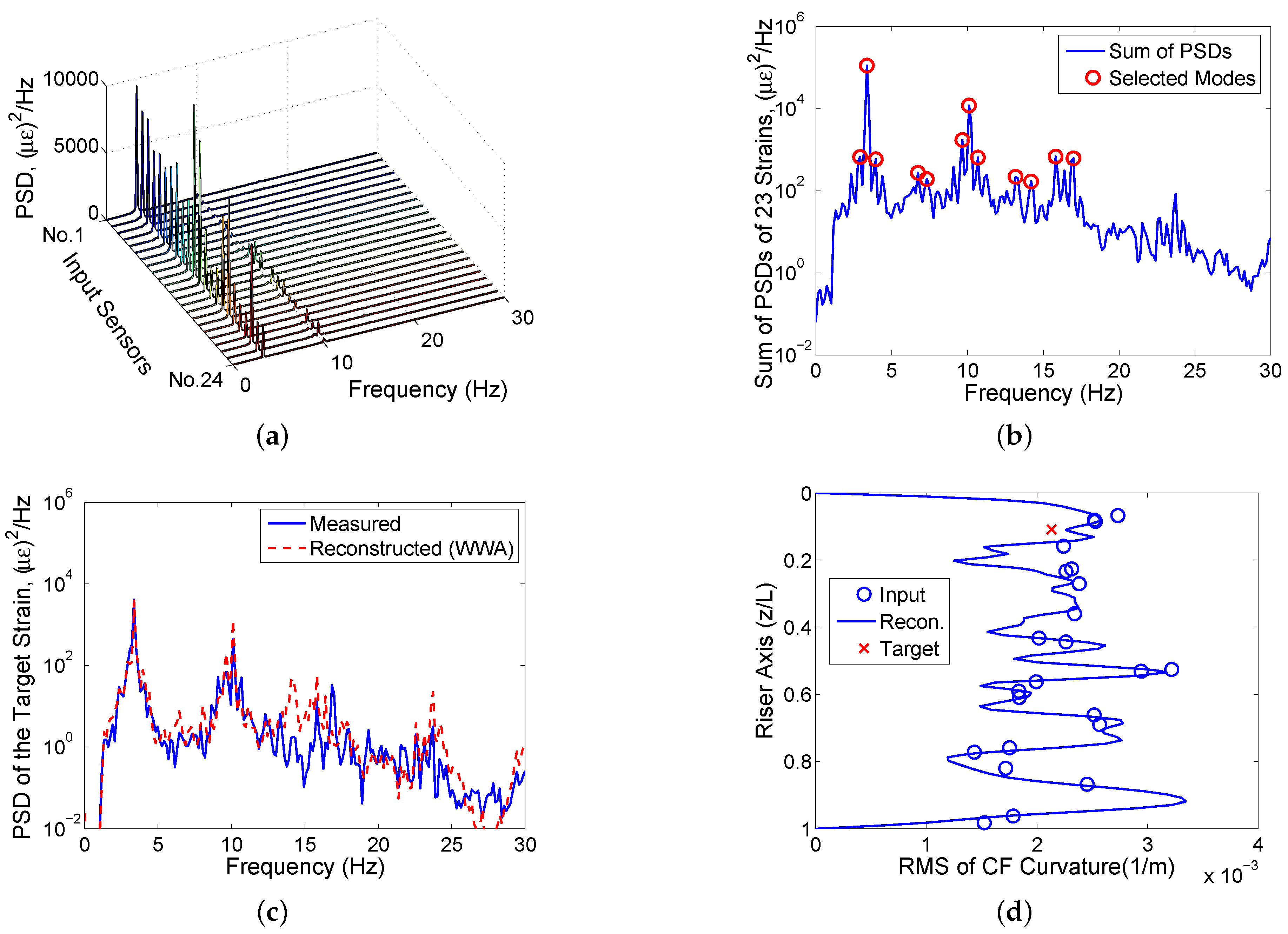
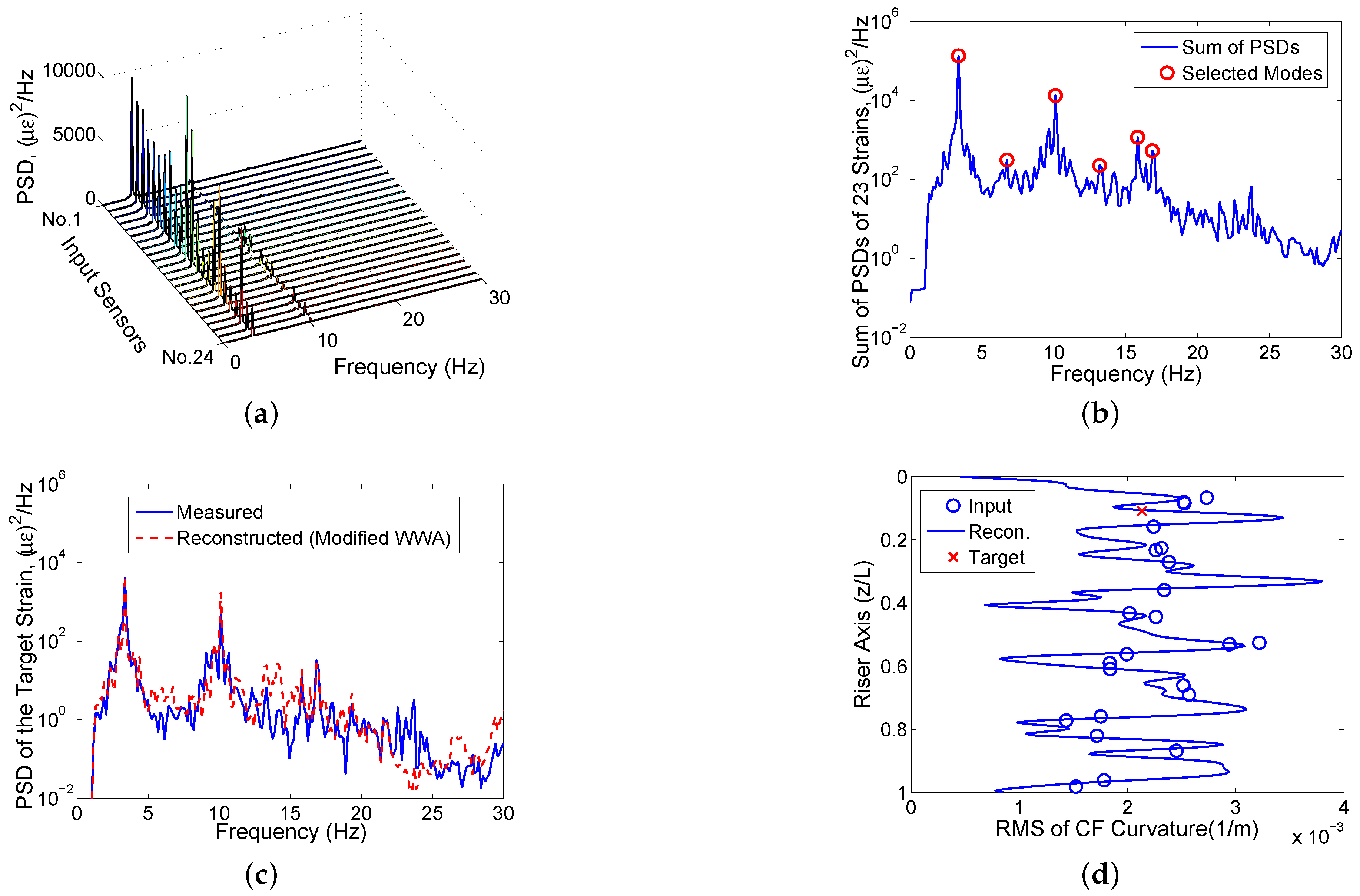
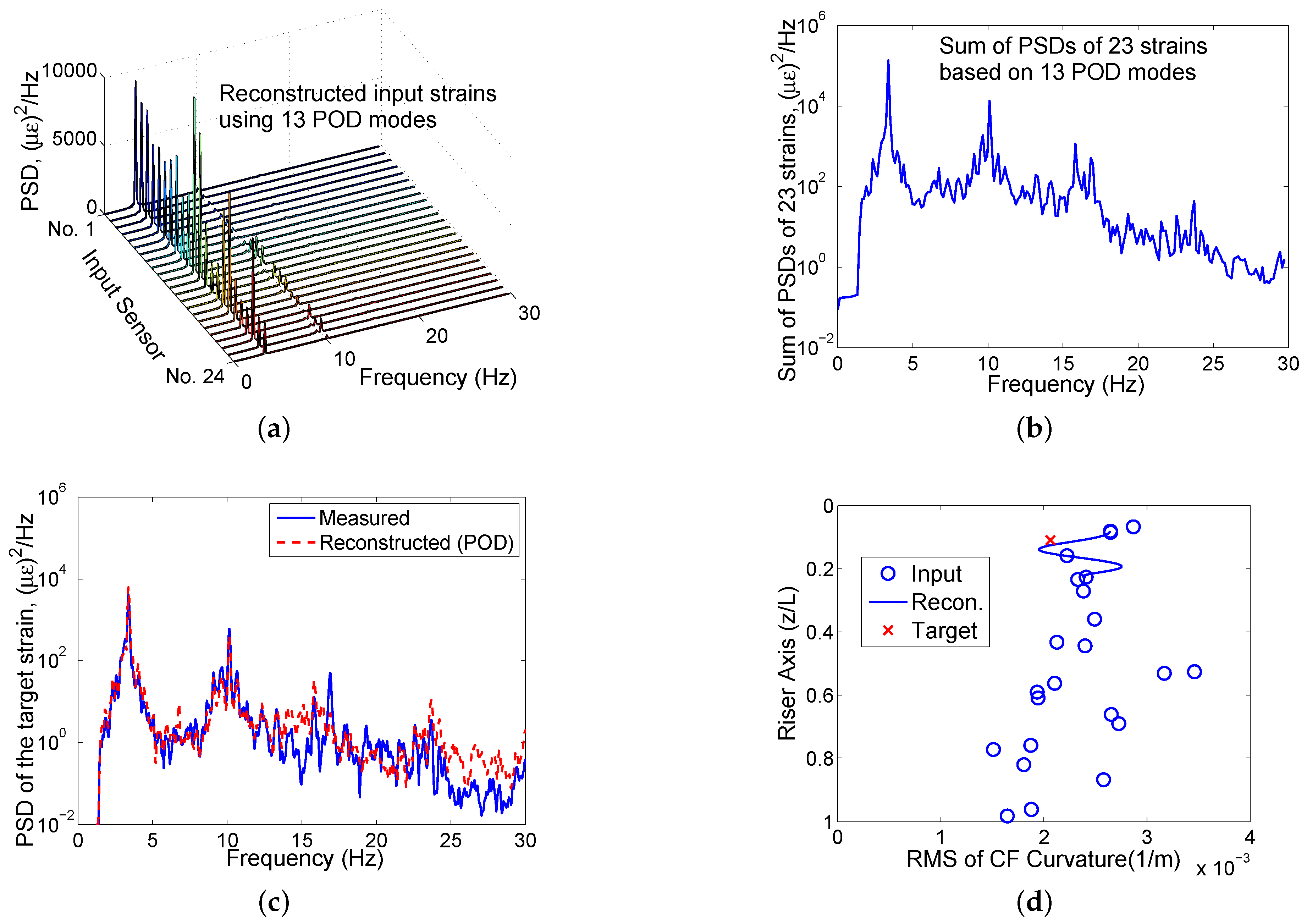
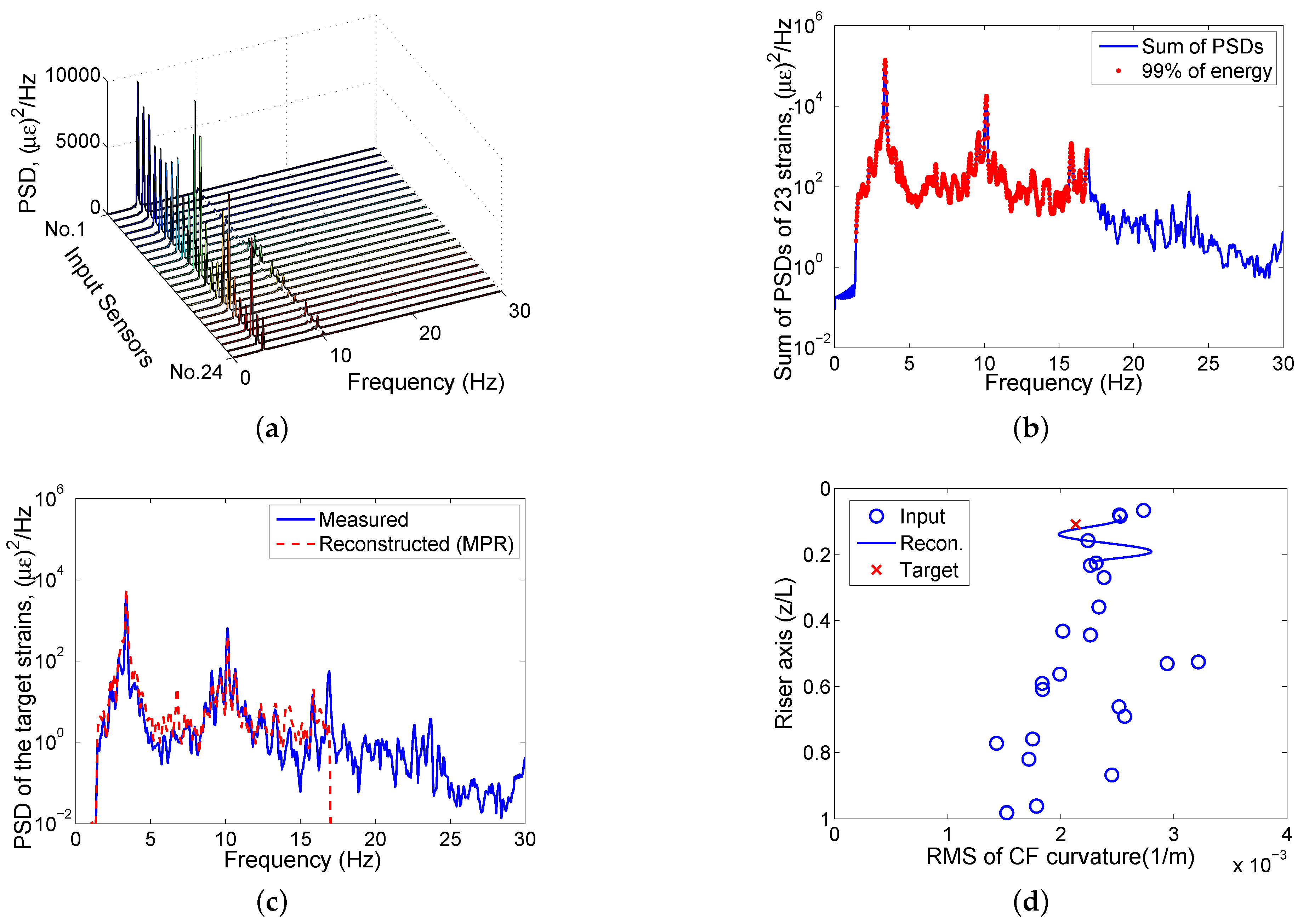

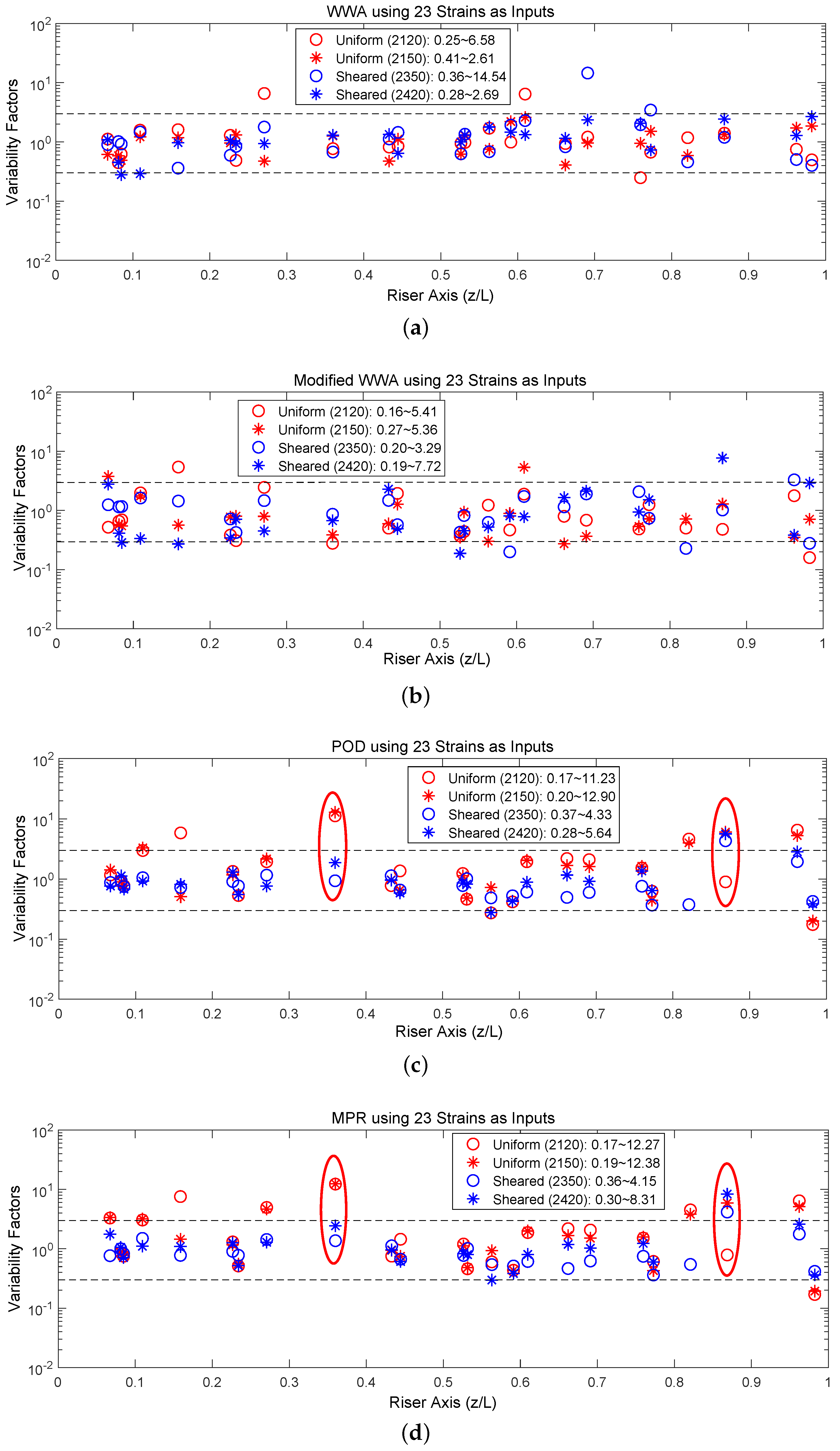
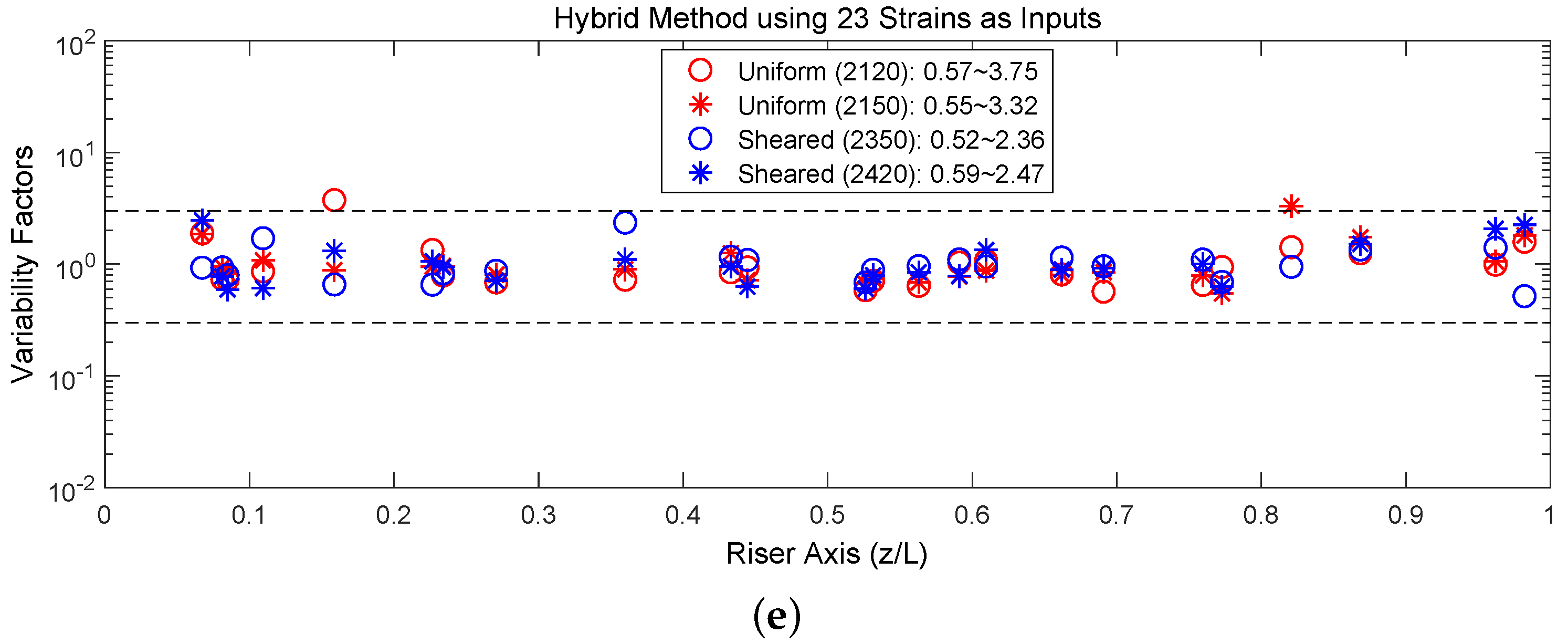
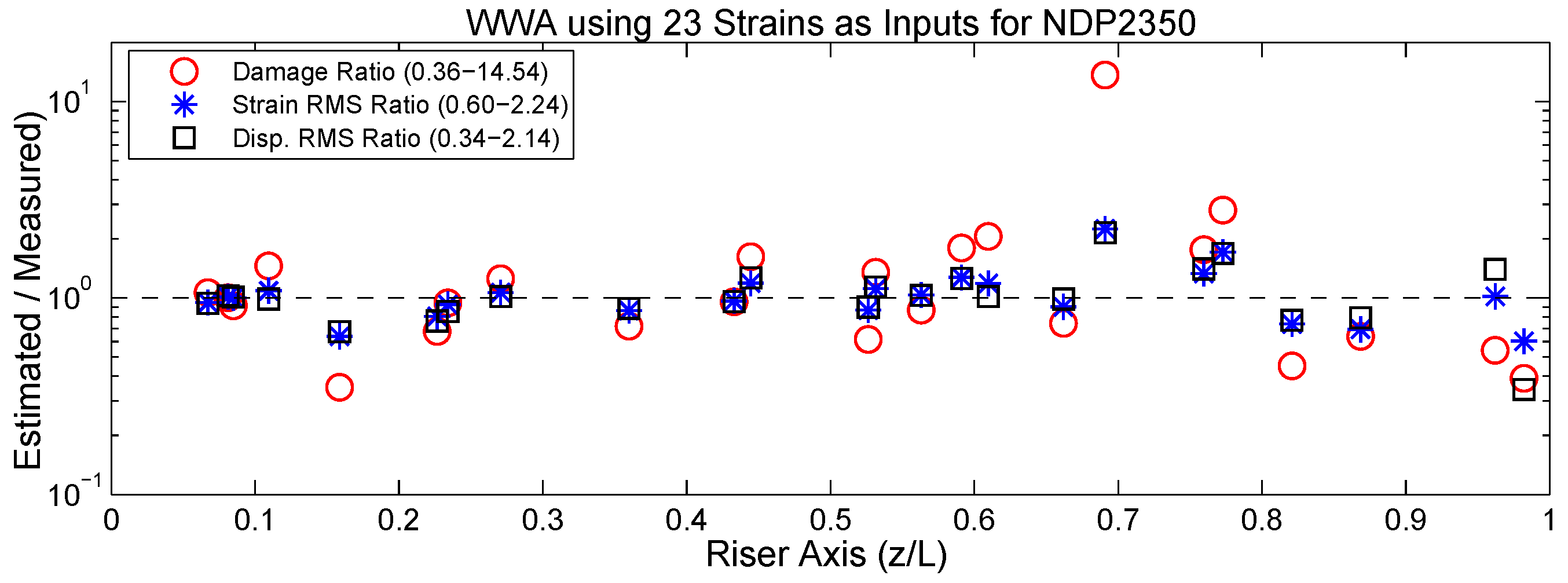
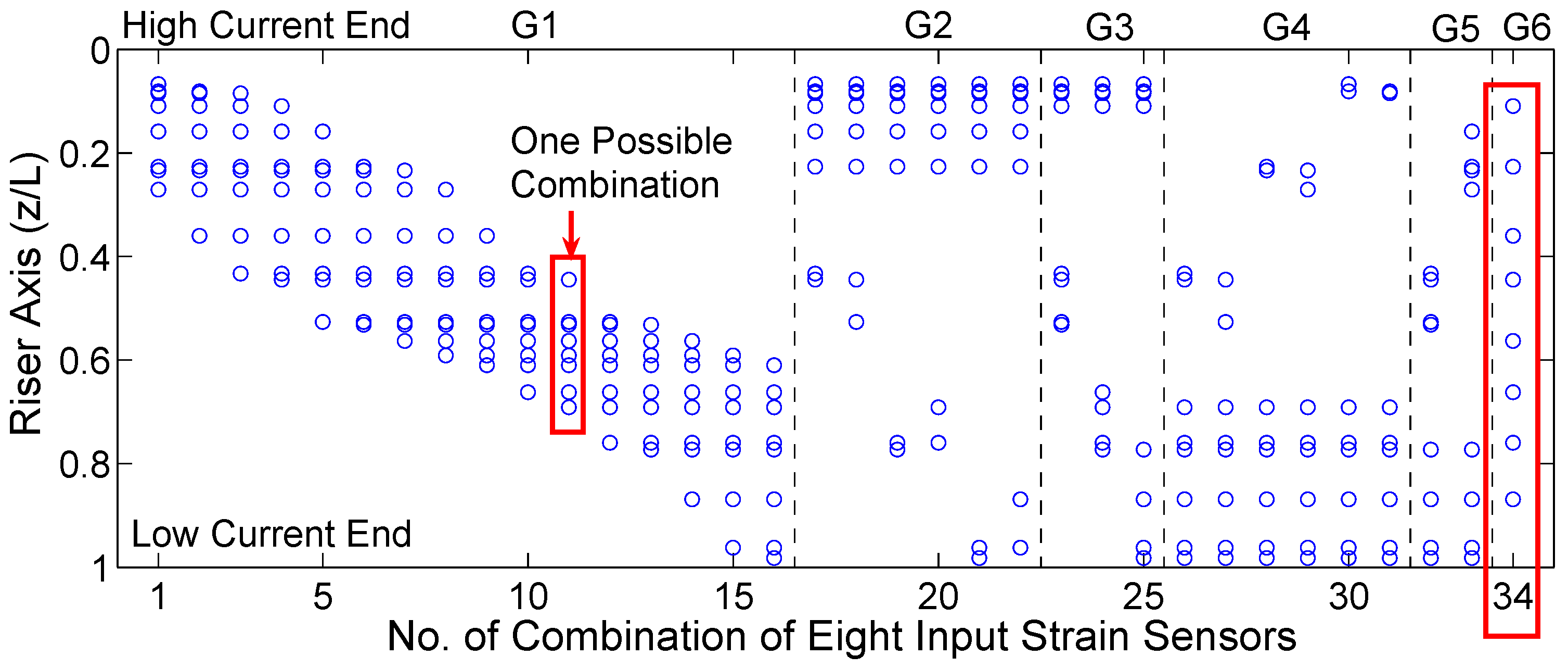
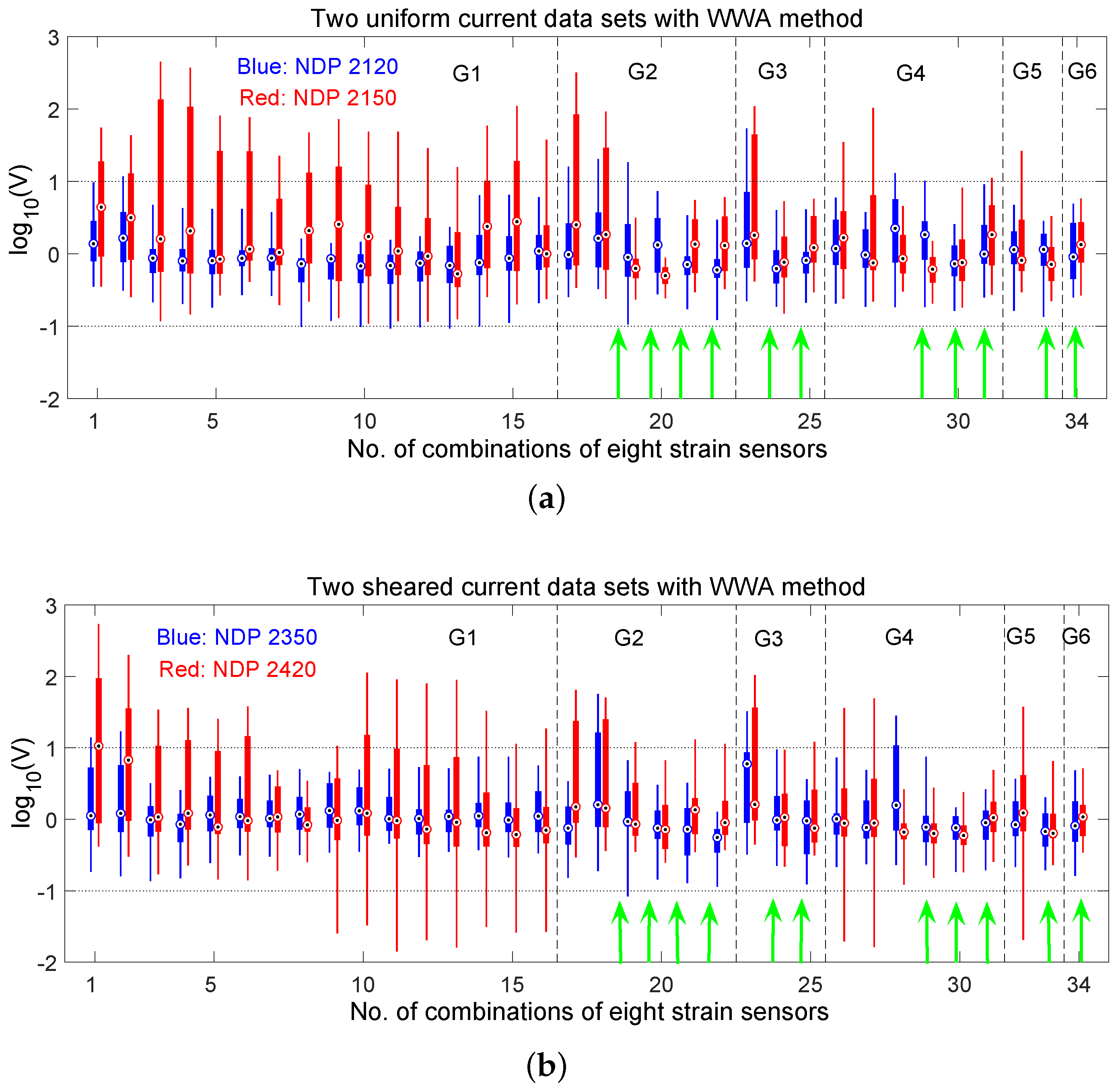



| Length (m) | 38 |
| Outer diameter (mm) | 27 |
| Wall thickness (mm) | 3 |
| Mass of riser per unit length (kg/m) | 0.933 |
| Mass of displaced water per unit length (kg/m) | 0.576 |
| Mean effective tension (N) | 4000 to 6000 |
| Bending stiffness (N-m2) | 598.8 |
| Maximum Reynolds number | ∼70,000 |
| Event No. | Current Profile | Max. Current Speed (m/s) | Largest RMS CF-disp./D | Duration (s) |
|---|---|---|---|---|
| 2120 | Uniform | 1.4 | 0.44 | 25 |
| 2150 | Uniform | 1.7 | 0.40 | 18 |
| 2350 | Sheared | 0.7 | 0.42 | 60 |
| 2420 | Sheared | 1.4 | 0.37 | 27 |
© 2018 by the authors. Licensee MDPI, Basel, Switzerland. This article is an open access article distributed under the terms and conditions of the Creative Commons Attribution (CC BY) license (http://creativecommons.org/licenses/by/4.0/).
Share and Cite
Shi, C.; Manuel, L.; Tognarelli, M. A Comparison of Empirical Procedures for Fatigue Damage Prediction in Instrumented Risers Undergoing Vortex-Induced Vibration. Appl. Sci. 2018, 8, 2085. https://doi.org/10.3390/app8112085
Shi C, Manuel L, Tognarelli M. A Comparison of Empirical Procedures for Fatigue Damage Prediction in Instrumented Risers Undergoing Vortex-Induced Vibration. Applied Sciences. 2018; 8(11):2085. https://doi.org/10.3390/app8112085
Chicago/Turabian StyleShi, Chen, Lance Manuel, and Michael Tognarelli. 2018. "A Comparison of Empirical Procedures for Fatigue Damage Prediction in Instrumented Risers Undergoing Vortex-Induced Vibration" Applied Sciences 8, no. 11: 2085. https://doi.org/10.3390/app8112085






